Weapon Wednesday: The Nugent Marathon Corinthian Helmet
Published
Categories
Author
Blog Post
The Corinthian helmet type is one of the most immediately recognisable types of helmet, romantically associated with the great heroes of Ancient Greece, even by the Ancient Greeks themselves who rapidly moved to helmet types with better visibility, but still depicted their heroes in these helmets. In modern portrayals of Ancient Greek warriors, it is always the Corinthian type that is depicted, although often modified to suit the look desired - for instance in one movie the helmet was modified to expose more of the face of the actor.
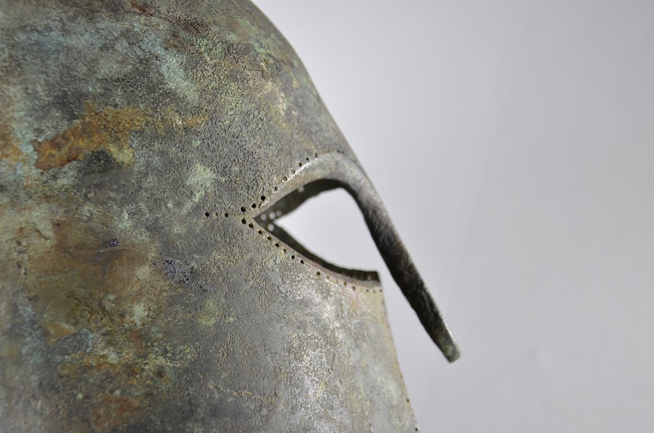
Detail of the Nugent Marathon helmet (ROM no.926.19.3 - photo Kay Sunahara) note the holes which may have been to fix a liner.
This specific helmet (ROM no.926.19.3) was purchased by the ROM in 1926 from T. Sutton of 2 Albemarle St., London, England, via Sotheby's (auction of 22 July 1926, lot 160). A skull (ROM No. 926.19.5) was said at one stage to be inside it, and in this condition was excavated by George Nugent-Grenville, 2nd Baron Nugent of Carlanstown, on the Plain of Marathon in 1834, according to letters from Sutton dated to 2 & 20 August 1826. Also a part of this lot, which sold for 80 pounds, was a helmet of "Spartan type" found by Nugent at Thermopylae in 1834 (ROM no. 926.19.4). Nugent (1788-1850) was High Commissioner of the Ionian Islands from 1832-5, but died without issue, and the Sutton letters state that the finds "came by descent in the family into the possession of the Boileau family, and remained with them until they were sold to me (Sutton) by Lt. Col.R.F. Boileau of Ketteringham Park, Norfolk".
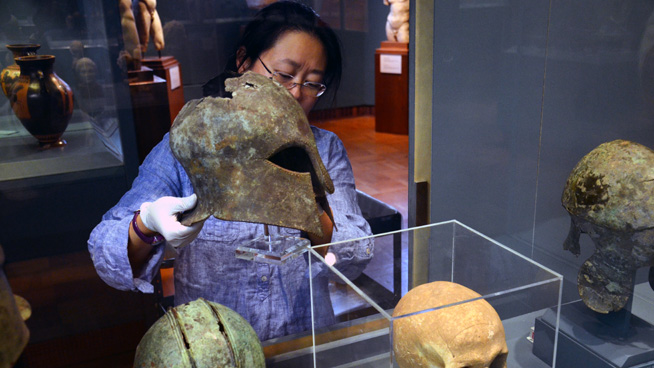
Kay Sunahara of the ROM's Greek & Roman section removing the helmet from the gallery for study.
The Battle of Marathon of 490 BC is thought to be one of the most pivotal battles in history, as it was in this battle that the Greeks defeated the invading Persians, thereby enabling the development of the Greek Classical civilisation. Thermopylae, being a narrow pass, was the site of a number of battles, but Nugent would probably have been interested in finds from the battle of 480 BC,the battle in which the 300 Spartans (plus some other Greeks that people tend not to talk about so much) held the pass against the invading Persians. How reliable this attribution is we cannot be entirely sure, but Nugent would have been in Greece very shortly after its freedom following the Greek War of Independence (1821-1832) during which the British Navy had been very influential, so it is conceivable that a British antiquarian digging around these sites could indeed find these helmets at these important sites, and they are indeed of the types that would be used on these dates.
As for the skull, it is difficult to be certain of the association. Since Marathon was a victory for the Greeks they would have been in a position to not leave any body parts or any useful equipment on the field, and the only damage to the helmet seems to be from age. So it is conceivable that it is just as unlikely that a helmet would be lost as much as the head that may have worn it, and we certainly have the helmet. I do not have any problem with the general idea of a helmet being found with a head still in it, as such things are found on battlefields, although typically not those of the victors. The alleged discovery of the object in 1834 seems sound, and Nugent may have been a romantic, but nothing in his biography would necessarily indicate a tale-spinner. However, 100 years passed between the finding of the object and our records, and we do not know how reliable may have been the transmission of information over that 100 years, perhaps especially since Nugent's house and contents were not inherited by his own children. Really, we cannot be certain that the skull belonged to the owner of the helmet, but really we cannot discount it, either. A DNA and radiocarbon study could tell us that it was a Greek of the time, but that is not presently planned.
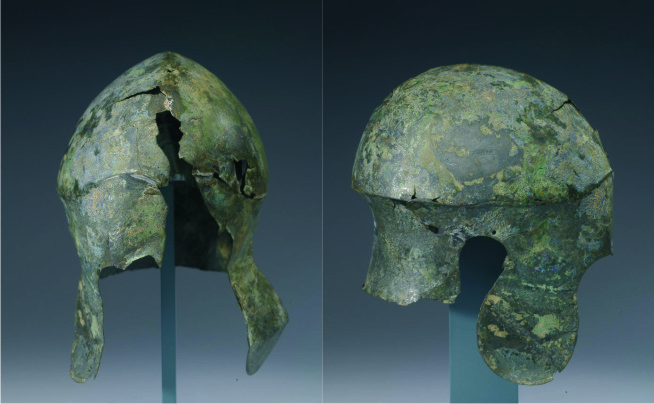
The Nugent Thermopylae helmet (ROM no. 926.19.4 - ROM Photography) of the "Chalcidian" type, a type used by Spartan hoplites.
I recently had occasion to examine the Nugent Marathon helmet to get information for Matt Lukes who makes equipment for reenactors, and who wanted to make a replica of the Corinthian helmet. In particular he wanted to know how it was fabricated. He was hoping that it had been raised from a sheet of bronze, and was hoping to make the replica from a bowl-like form made on a lathe by "spinning" the bronze sheet, which is then raised to final shape. Apart from looking at details of manufacture, I also looked at the thickness of the helmet in various parts, recorded in the photographs, below. The weight of the helmet is 1193.1 grams, and is only missing a part of the very thin crown, so this is probably close to the original weight (the weight of a WW2 American M1 helmet is about 1300 grams, and the British Mark II is 1050 grams). The face is relatively thick, the nasal itself is up to 10 mm, and where I can reach with the calipers on the face it is between 2 mm and 3 mm. The rest of the face seems to be of this thickness, but it is not possible to measure it. The back and especially the crown is very thin, becoming under one mm thick, and here it is clearly possible to see that the edge of the helmet is thicker, and rapidly thins. This would make it a very effective protection for the face when it's owner is facing their enemy, but of little use against anyone bashing them on the back of the head! Such strength would be perfect for the spear and shield hoplite warfare of the Greeks in this period, in which fighting seems to have been undertaken by spear thrusts over or around the large round shield, so the face needs protection, and the shins are protected by the heavy greaves, but that is all.
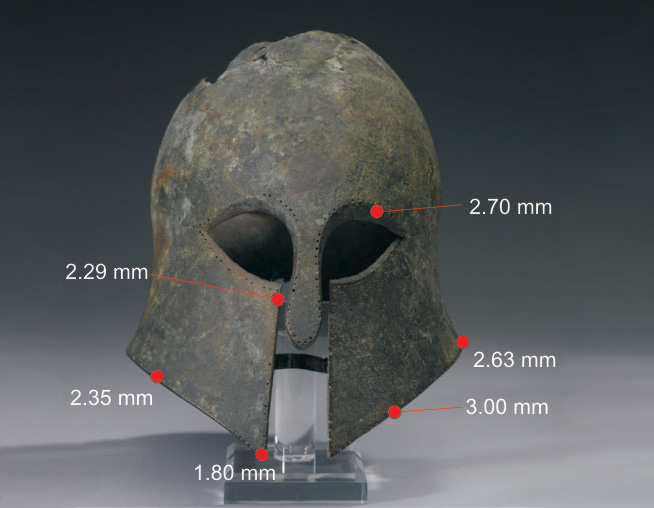
Front of the Nugent Marathon helmet (ROM no.926.19.3 - original image by ROM Photography)
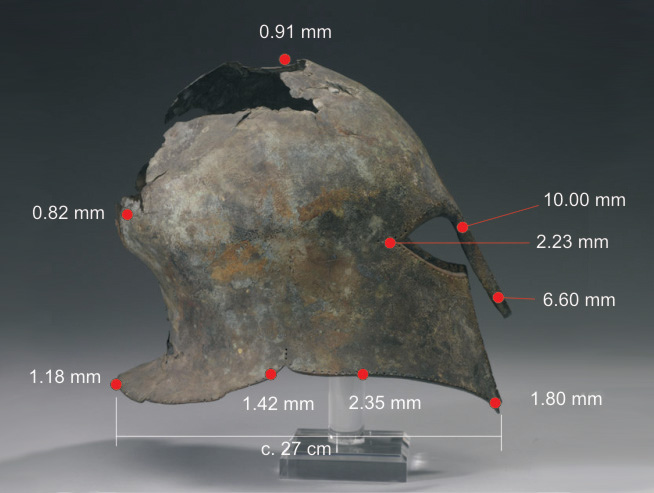
Side view of the Nugent Marathon helmet (ROM no.926.19.3 - original image by ROM Photography)
With regard to the manufacture of this helmet, it rather looks as though the face and the general form of the helmet was cast, and then the final bowl of the helmet was sunk, being hammered until it was in its final shape. This would make it very expensive to reproduce, but Matt will be trying to recreate the helmet in the next few months. I will show you how he does!
Further reading
Paul Denis - curator responsible for the Ancient Greece collection
These helmets are on display in the Ancient Greece Gallery
George Nugent-Grenville, 2nd Baron Nugent


